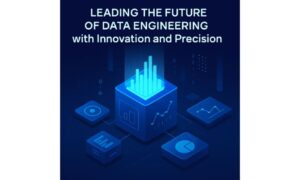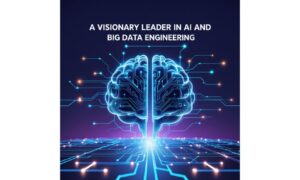Akshay Agarwal is a seasoned Lead Data Engineer with over twelve years of experience in designing, developing, and implementing cutting-edge data solutions. His expertise spans cloud migration, data analytics, and Artificial Intelligence, with a focus on optimizing data workflows and ensuring high data quality. Agarwal is dedicated to advancing business data-driven decision-making through innovative approaches and staying abreast of the latest industry trends. His commitment to excellence in data engineering continues to drive meaningful change and inspire progress in the field. In this interview, Akshay discusses his journey, challenges and the future of data and AI.
In the fast-paced world of data analytics, the ability to transform vast amounts of complex data into actionable insights is becoming increasingly critical for businesses to remain competitive. Akshay Agarwal, a Lead Data Engineer at a prominent SaaS company, is at the cutting edge of this transformation. By revolutionizing data visualization techniques and creating highly efficient, user-friendly dashboards, Agarwal is empowering businesses to make informed decisions that are crucial for their growth and success.
Reflecting on his data journey and what intrigued him, Akshay said, “ My journey started with a deep interest in computer science and data systems. From the very beginning, I was drawn to the challenge of transforming raw data into meaningful, actionable insights. Early on, I realized how critical data could be in driving decision-making across businesses. As I progressed, I found myself specializing in cloud migration, data analytics, and AI, which are all crucial for building scalable and efficient data workflows. Over the years, this passion evolved into a career where I’ve had the opportunity to work on projects in various industries like banking and finance, and restaurants, that not only enhance data quality but also empower businesses to make better decisions.”
At the core of Agarwal’s recent contributions is his innovative approach to data visualization. Data visualization is more than just creating aesthetically pleasing charts and graphs; it is about transforming raw data into meaningful insights that can be easily understood and acted upon. Agarwal recognized the need for businesses to have access to real-time, accurate data presented in a way that supports strategic decision-making.
To address this, Agarwal spearheaded a project to overhaul the analytics and visualization framework at his organization. The goal was to create an analytics dashboard that not only displayed data but provided a comprehensive view of the business’s performance metrics in real-time. By doing so, businesses could react more swiftly to emerging trends, optimize operations, and make data-driven decisions that support long-term growth.
This project required a deep understanding of the specific needs of the business and its users. Agarwal worked closely with data scientists, product managers, and key stakeholders to ensure that the dashboards would meet their expectations. His approach emphasized usability and accuracy, ensuring that the data presented was both relevant and actionable. This level of customization allowed different users—from executives to operations teams—to interact with the data in ways that were meaningful to their roles, leading to better overall decision-making.
Talking about Akshay’s work at Fourth, a SaaS company focused on the restaurant and hospitality industry and how his work impacted the businesses in this industry, Akshay said, “One of the most exciting aspects of my current role is the chance to see the tangible impact of data engineering and Artificial Intelligence on business operations. In my role, I’ve been able to overhaul how data is visualized and accessed. A big part of this has been creating intuitive, user-friendly dashboards that allow businesses to make informed, real-time decisions. In the restaurant and hospitality sector, for example, having access to data on things like sales performance, inventory, and employee productivity has helped many businesses optimize their operations. Some have even reported a 15% increase in sales and improved forecasting for staffing schedules.”
During his time at Fourth, Akshay focused on Predictive analytics and real-time data insights using AI. “One example that comes to mind is a project where we helped restaurant owners improve their operations through real-time data. By providing them with dashboards that tracked sales, inventory, and employee productivity, they could optimize their staffing schedules, reduce waste, and improve customer service. This level of insight led to better operational efficiency and, as a result, a boost in profitability. One restaurant reported a 25% improvement in forecasting worker shifts, while others saw a 15% increase in sales”, which he views as his highlight at Fourth.
Akshay led and significantly contributed to data visualization by building dashboards. When asked about some challenges he faced, Akshay said “Data visualization is a lot more than just creating charts and graphs. It’s about turning raw data into insights that are both accurate and actionable. To achieve this, I worked closely with data scientists, product managers, and key stakeholders to design a system that was customized to their needs. We made sure the dashboards were intuitive and accessible to all users, from executives to operations teams, so they could make decisions quickly and confidently.”
It seems like data-driven decisions really made a big difference for the businesses in the restaurant industry. During the interview, when asked about how his work has the border economic impact, Akshay said “when businesses optimize their operations and make smarter, data-driven decisions, the effects ripple outward. For instance, some of our clients have been able to expand their businesses, hire more employees, and invest in new technologies, all thanks to the efficiency gains from our AI and data solutions. This, in turn, contributes to job creation in the US and overall economic growth.”
Looking Ahead: The Future of Data Visualization
As businesses continue to evolve in an increasingly data-driven world, the importance of innovative data visualization will only grow. Akshay Agarwal’s work serves as a model for how organizations can harness the power of data to drive growth, improve efficiency, and make informed decisions.
Looking ahead, Agarwal is committed to staying at the forefront of data engineering and visualization trends. He said, “my future projects will likely focus on further integrating AI and machine learning into data workflows, enabling even more sophisticated predictive analytics and automation capabilities. By continuing to push the boundaries of what’s possible in data engineering, I’ll undoubtedly continue to drive meaningful change and inspire progress in the field.” Further talking about someone stepping into the data engineering world, Akshay said “My advice would be to stay curious and never stop learning. Data is a field that’s constantly evolving, and the best way to stay ahead is to keep experimenting with new tools, technologies, and techniques. Don’t be afraid to dive deep into complex topics—whether it’s AI, cloud migration, or advanced analytics. Always keep the end-user in mind. Ultimately, the goal is to make data not just accessible, but meaningful for people so they can make better decisions.”



































